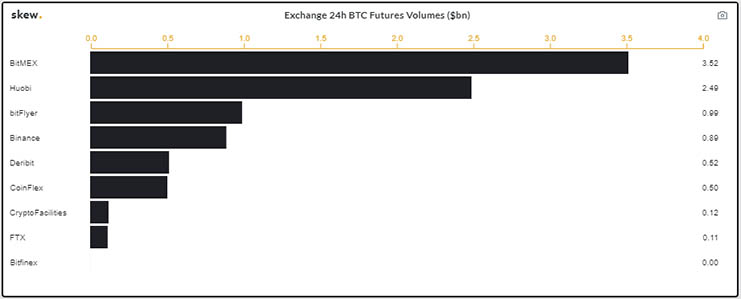Lately, daily BTC spot trading volumes are being eclipsed by those of Bitcoin futures. Could this be a sign that the market is maturing or are traders just bored with the lack of recent volatility?
According to recent estimates from data trackers Skew and BitcoinTradeVolume, the daily trading volume of Bitcoin futures is nearly 10 times that of the spot market.
Data from both sources show 24-hour Bitcoin futures trading volumes of more than US$9.3 billion [AU$13.5 billion] compared to just $1.2 billion in spot trades over the same period – and that doesn’t count OKEx Bitcoin futures, which weren’t included in the data.
Asia-based exchanges, such as BitMex, OKEx, and Huobi, make up most of that volume, with BitMex alone trading nearly $3.5 billion worth of Bitcoin futures in the past 24 hours.
OKEx (not shown on the table) is a close second with $3.12 billion while Huobi comes in at third with $2.46 billion.
Andy Cheung, the head of Hong Kong operations for OKEx, told Bloomberg on Tuesday that twice as many people have been trading Bitcoin derivatives on the exchange than actual coins in 2019.
Another testament to just how big and lucrative the Bitcoin futures trading market has become is Binance.
One of the world’s largest spot exchanges by trading volume, Binance launched its own Bitcoin futures platform – Binance Futures – last month.
That same month, Binance also acquired the crypto derivatives platform JEX. Between the two platforms, Binance’s 24-hour trading volume for Bitcoin futures is more than $937 million.
 Bitcoin futures trading volumes (Skew)
Bitcoin futures trading volumes (Skew)
What is pushing traders into Bitcoin futures?
When it comes to determining the impetus behind the sudden influx of futures trades, there are three prevailing theories – price, boredom, and market maturity.
Changpeng Zhao, the CEO of Binance, pointed out that Bitcoin futures trading is often cheaper than spot trading thanks to leverage.
“When trading with leverage, traders don’t have to tie up as much capital as you would trading spot,” he said.
Last week, Binance introduced leverage of as much as 125x the value of the contract, becoming a direct competitor to platforms such as BitMex, which offers a 100x leverage on its futures products.
Still, BitMex remains king of the futures trading platforms – for now at least. The exchange holds the lion’s share of the crypto derivatives market and pulls in more than $700,000 per day in fees from derivatives trading.
“BitMex is probably at the center of the whole ecosystem right now,” Sid Shekhar, co-founder of London-based tracker TokenAnalyst, said.
The exchange itself has said that the lack of daily volatility Bitcoin has seen lately – recent declines notwithstanding – has pushed bored traders into derivatives trading.
Data from Coinmetrics shows that, at just 2.58 percent, Bitcoin volatility is at its lowest since April of this year.
 Bitcoin volatility hits 6.5-month low (Coin Metrics)
Bitcoin volatility hits 6.5-month low (Coin Metrics)
Of course, it could simply be that the market is beginning to mature. This is the theory that eToro senior analyst Mati Greenspan seems to be leaning towards.
Micky spoke with Greenspan to get his take on the recent development and, given the choice between boredom and market maturity, he is firmly in the latter camp.
“Markets don’t generally trade on boredom,” Greenspan said, adding, “The spate of volatility seems to have inspired further action.”
He is referring, of course, to Bakkt’s record-breaking performance today. Despite Bitcoin dropping below $7,500, trading volumes on the ICE-owned futures exchange have reached a new all-time high.
At the time of writing, Bakkt has traded 579 contracts for 1 BTC each – an estimated at more than $4.3 million based on the last traded price.
The post Why is Bitcoin futures trading outperforming spot trading 10 to 1? appeared first on Micky.